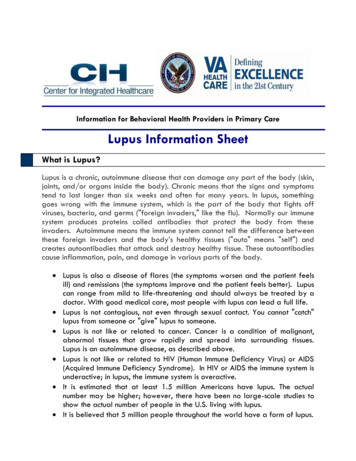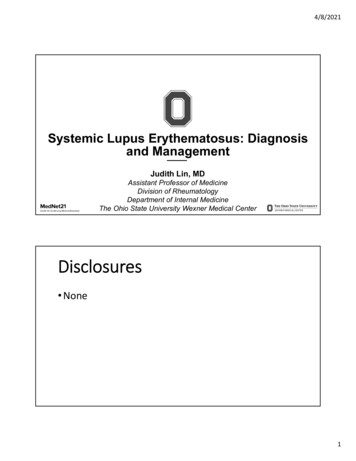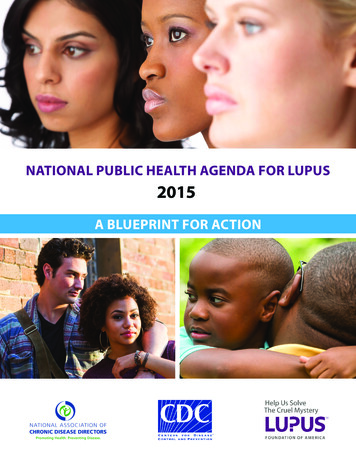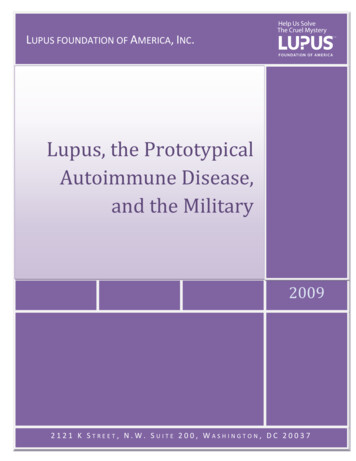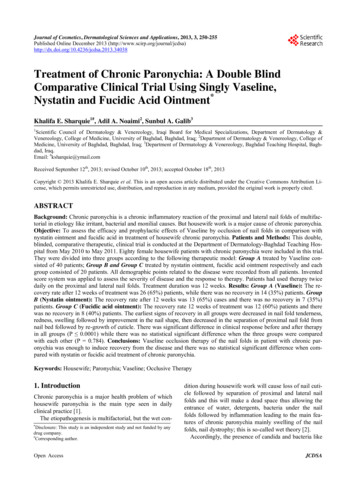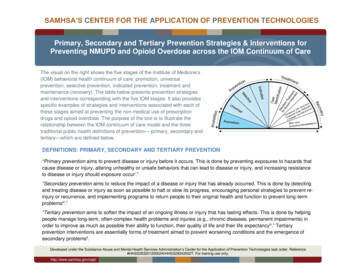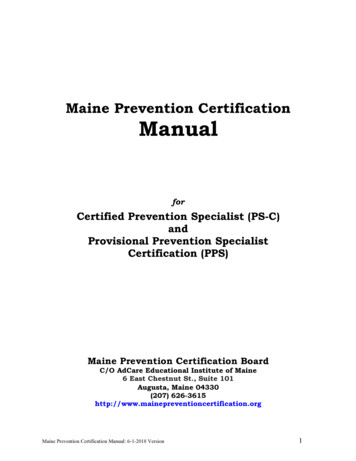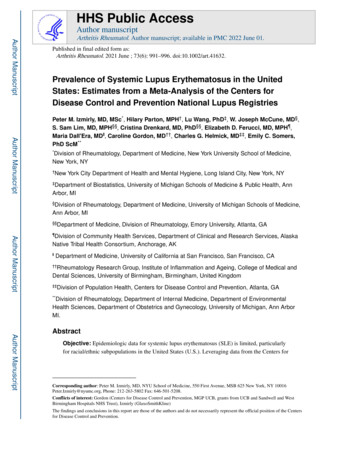
Transcription
HHS Public AccessAuthor manuscriptAuthor ManuscriptArthritis Rheumatol. Author manuscript; available in PMC 2022 June 01.Published in final edited form as:Arthritis Rheumatol. 2021 June ; 73(6): 991–996. doi:10.1002/art.41632.Prevalence of Systemic Lupus Erythematosus in the UnitedStates: Estimates from a Meta-Analysis of the Centers forDisease Control and Prevention National Lupus RegistriesAuthor ManuscriptPeter M. Izmirly, MD, MSc*, Hilary Parton, MPH†, Lu Wang, PhD‡, W. Joseph McCune, MD§,S. Sam Lim, MD, MPH§§, Cristina Drenkard, MD, PhD§§, Elizabeth D. Ferucci, MD, MPH¶,Maria Dall'Era, MDǁ, Caroline Gordon, MD††, Charles G. Helmick, MD‡‡, Emily C. Somers,PhD ScM***Divisionof Rheumatology, Department of Medicine, New York University School of Medicine,New York, NY†NewYork City Department of Health and Mental Hygiene, Long Island City, New York, NY‡Departmentof Biostatistics, University of Michigan Schools of Medicine & Public Health, AnnArbor, MI§Divisionof Rheumatology, Department of Medicine, University of Michigan Schools of Medicine,Ann Arbor, MI§§Departmentof Medicine, Division of Rheumatology, Emory University, Atlanta, GAAuthor Manuscript¶Divisionof Community Health Services, Department of Clinical and Research Services, AlaskaNative Tribal Health Consortium, Anchorage, AKǁDepartment of Medicine, University of California at San Francisco, San Francisco, CA††RheumatologyResearch Group, Institute of Inflammation and Ageing, College of Medical andDental Sciences, University of Birmingham, Birmingham, United Kingdom‡‡Divisionof Population Health, Centers for Disease Control and Prevention, Atlanta, GA**Divisionof Rheumatology, Department of Internal Medicine, Department of EnvironmentalHealth Sciences, Department of Obstetrics and Gynecology, University of Michigan, Ann ArborMI.Author ManuscriptAbstractObjective: Epidemiologic data for systemic lupus erythematosus (SLE) is limited, particularlyfor racial/ethnic subpopulations in the United States (U.S.). Leveraging data from the Centers forCorresponding author: Peter M. Izmirly, MD, NYU School of Medicine, 550 First Avenue, MSB 625 New York, NY 10016Peter.Izmirly@nyumc.org, Phone: 212-263-5802 Fax: 646-501-5208.Conflicts of interest: Gordon (Centers for Disease Control and Prevention, MGP UCB, grants from UCB and Sandwell and WestBirmingham Hospitals NHS Trust), Izmirly (GlaxoSmithKline)The findings and conclusions in this report are those of the authors and do not necessarily represent the official position of the Centersfor Disease Control and Prevention.
Izmirly et al.Page 2Author ManuscriptDisease Control and Prevention (CDC) National Lupus Registry network of population-based SLEregistries, a meta-analysis estimating U.S. SLE prevalence was performed.Methods: The CDC National Lupus Registry network included four registries in unique statesand a fifth in the Indian Health Service (IHS). All registries used the 1997 revised AmericanCollege of Rheumatology (ACR) classification criteria for the SLE case definition. Case findingspanned either 2002-2004 or 2007-2009. A random effects model was employed givenheterogeneity across sites. Applying sex/race-stratified estimates to the 2018 Census population,an estimate for the number of SLE cases in the U.S. was generated.Author ManuscriptResults: 5,417 cases fulfilled the ACR SLE classification criteria. Pooled prevalence from thefour state-specific registries was 72.8/100,000 (95%CI:65.3,81.0), 9 times higher for females thanmales (128.7 vs 14.6), and highest among Black females (230.9), followed by Hispanic (120.7),white (84.7) and Asian/Pacific Islander females (84.4). Male prevalence was highest in Blackmales (26.7) followed by Hispanic (18.0), Asian/Pacific Islander (11.2), and white males (8.9).The American Indian/Alaska Native had the highest race-specific SLE estimates for females(270.6/100,000) and males (53.8/100,000). In 2018, 204,295 persons (95% CI:160,902,261,725)in the U.S. fulfilled ACR SLE classification criteria.Conclusions: A coordinated network of population-based SLE registries provided moreaccurate estimates for SLE prevalence and numbers affected in the U.S.KeywordsSystemic lupus erythematosus; Meta-Analysis; Epidemiology; public health surveillanceINTRODUCTIONAuthor ManuscriptThe heterogeneity of the clinical manifestations of systemic lupus erythematosus (SLE) andlack of a singular diagnostic test make SLE difficult for epidemiologists to study (1).Previous estimates for SLE rates in the United States (U.S.) have been predominantlyderived from tertiary care settings and relatively small, homogeneous patient populationsthat contain limited data on key demographic groups in the U.S. (1). Other explanations forthe varied estimates, which range from 19-241 per 100,000, include racial/ethnic disparitiesin SLE susceptibility and mortality, differing case definitions, heterogeneous sources forcase ascertainment, small populations, possible inaccuracy of self-report, unreliability incoding in health system databases, and variable access to health care for high-riskpopulations (2, 3).Author ManuscriptThe Centers for Disease Control and Prevention (CDC) funded a network of five populationbased SLE registries, each using similar active surveillance methods, to determine SLEincidence and prevalence in populations reflecting a broad distribution of racial/ethnicdemographics in the U.S. Data from these five registries have provided overall prevalenceand incidence rates of SLE, as well as estimates that focused on the major U.S. demographicgroups, including whites and Blacks (3, 4), Asians/Pacific Islanders and Hispanics (5, 6) andAmerican Indians/Alaska Natives (AI/AN) (7). Leveraging these data, we performed a metaanalysis to estimate the overall prevalence of SLE and to provide an estimate of the numberof SLE cases in the U.S. in 2018.Arthritis Rheumatol. Author manuscript; available in PMC 2022 June 01.
Izmirly et al.Page 3Author ManuscriptMETHODSData Sources and Study SelectionAuthor ManuscriptAuthor ManuscriptThe CDC-supported and SLE-dedicated registries were based in the following sourcepopulations which contained a mix of urban and rural areas: Georgia (Fulton & DeKalbCounties – Georgia Lupus Registry (GLR)) (3) and Michigan (Washtenaw & WayneCounties – Michigan Lupus Epidemiology and Surveillance Program (MILES)) (4), both ofwhich have a large Black population (approximately 50%); California (San FranciscoCounty – California Lupus Surveillance Program, CLSP)) (5) and New York (New YorkCounty – Manhattan Lupus Surveillance Program (MLSP)) (6), which have populations withsubstantial representation of Asian/Pacific Islanders and Hispanics; and the Indian HealthService (IHS) (IHS facilities from Alaska, Phoenix, and Oklahoma City areas) (7), whichprovided estimates for the AI/AN population. Active surveillance for these registries wasperformed at various times between 2003-2015 using the surveillance exemption to HIPAAand public health authorization by respective State or City Health Departments, whichallowed access to medical records without individual consent. The case definitions for SLEprevalence varied slightly by the time period evaluated in each registry with all taking placebetween 2002-2009 (3-7). All registries used the 1997 revised American College ofRheumatology (ACR) classification criteria for SLE as the primary case definition for SLE(8, 9). The registries employed harmonized methods, including the utilization of a variety ofcase-finding sources and screening for potential SLE cases using the same core set of ICD-9codes. Registries used a consistent approach to capture the relevant clinical and demographicinformation and core definitions from a standardized data dictionary. Trained medicalabstractors who underwent routine quality assurance monitoring collected the data.Population denominators were based on intercensal population estimates for the respectivesource populations. Sex- and race/ethnicity-specific prevalence estimates were calculated per100,000 person-years and age-adjusted to the 2000 U.S. Standard Population,Supplementary Figure 1 (10). Data were extracted from the published manuscripts by twoauthors independently (PI & HP) who agreed on all data used.Data Synthesis and AnalysisA meta-analysis was conducted to derive pooled prevalence estimates using data from foursimilar CDC-funded registries based in states (GLR, MILES, CLSP and MLSP) for the agestandardized prevalence (adjusted to the 2000 U.S. Standard Population) (10) and for ratesstratified by sex and race/ethnicity categories other than AI/AN (3-6). In contrast to the 4state-based registries, the IHS-based registry (7) was different, focusing on one demographic(American Indian/Alaska Natives; AI/AN) and thus was handled separately.Author ManuscriptFor the meta-analysis, heterogeneity across sites was tested by Cochran’s Q and I2 statistic(11, 12). Due to significant heterogeneity, we used a random effects model, weighted by thepopulation denominator for each site, to calculate pooled prevalence (13). Such randomeffects models allow an underlying distribution of the effect sizes across different studies.Pooled race- and ethnicity-specific estimates were calculated, except for the AI/ANestimate, which was based solely on the IHS registry that covered multiple states.Arthritis Rheumatol. Author manuscript; available in PMC 2022 June 01.
Izmirly et al.Page 4Author ManuscriptIn the MLSP publication (6), rates were presented as combined race and ethnicity categories(e.g., non-Hispanic white). For this meta-analysis, race and ethnicity rates were calculatedseparately for consistency across the registries based in states. Hispanic ethnicity and racecategories overlap, so Hispanic estimates include all races and each race category includesHispanics (i.e., race and Hispanic ethnicity are not mutually exclusive).To estimate the number of SLE cases in the U.S., the pooled age-adjusted sex- and racespecific prevalence rates from the four states and the AI/AN prevalence from the IndianHealth Service were separately extrapolated to 2018 U.S. Census population data; thesestratum-specific estimates were then summed for the total population count. The pooledprevalence estimates do not incorporate the Hispanic rates because that would lead toduplicate counting.Author ManuscriptRESULTSPrevalenceAuthor ManuscriptThe five registries contributed 5,417 SLE cases fulfilling ACR classification criteria fromdiverse areas across the country. The random effects model for the meta-analysis ofestimates from the four registries based in states yielded an overall SLE prevalence of 72.8per 100,000 (95% CI: 65.3, 81.0); Figure 1A. The prevalence among females was about 9times higher than males (128.7 vs 14.6); Table 1. From the race- and ethnicity-specificpooled estimates from the four state-specific registries, prevalence was the highest amongBlack females (230.9, 95% CI: 178.2, 299.2), followed by Hispanic females (120.7, 95% CI:84.0, 173.4), white females (84.7, 95% CI 68.4, 104.8), and Asian/Pacific Islander females(84.4, 95% CI: 48.3, 147.4); Figure 1B, Table 1. Among males, prevalence followed asimilar pattern, with the highest rates among Black males (26.7, 95% CI: 19.6, 36.4),followed by Hispanic males (18.0, 95% CI 15.6, 20.8), Asian/Pacific Islander males (11.2,95% CI: 5.7, 21.9), and white males (8.9, 95% CI: 8.0, 10.1), Figure 1C, Table 1.The prevalence estimates for AI/AN from the IHS Registry (not included in the pooledmeta-analysis estimates from the four registries based in states) were the highest for all racesfor both females (270.6, 95% CI: 237.5, 307.0) and males (53.8, 95% CI: 36.2, 77.1),Figures 1B and 1C, Table 1.Numbers of SLE cases in the United StatesAuthor ManuscriptApplying the sex- and race-specific prevalence estimates to the corresponding stratumspecific population denominators from 2018 U.S. Census data, we estimated that 204,295persons (95% CI: 160,902, 261,725) in the U.S. fulfilled ACR SLE classification criteria;Table 1.DISCUSSIONUsing the ACR classification criteria to clinically define SLE, overall SLE prevalence in theU.S. was estimated to be 72.8 per 100,000 (95% CI: 65.3, 81.0) during calendar years2002-2009. Prevalence was approximately 9 times higher in females compared to males, andhighest among American Indians/Alaska Natives and Black females. Extrapolating sex- andArthritis Rheumatol. Author manuscript; available in PMC 2022 June 01.
Izmirly et al.Page 5Author Manuscriptrace-specific estimates to 2018 U.S. Census data, we estimated that 204,295 (95% CI:160,902, 261,725) persons (184,323 females and 19,972 males) in the U.S. fulfilled ACRSLE classification criteria.Author ManuscriptAuthor ManuscriptLimitations and strengths for each of the five component registries have been previouslydescribed (3-7). There are several limitations. First, although the registries were designed toemploy similar methods, there were subtle differences in the comprehensive case findingsources that were approached by the different registries and the ICD-9 criteria used toidentify possible cases. Second, case finding may have missed some true cases meeting theACR criteria, so the actual numbers may be slightly higher than these estimates asdemonstrated by the capture-recapture analyses conducted by the state-based registries (3-6).Third, data on race and ethnicity were abstracted from medical records that may notaccurately represent the patient’s own racial or ethnic identification. Hispanic ethnicity andthe different races encompass several heterogeneous groups, and SLE rates among them maydiffer. Fourth, AI/AN prevalence was based on one registry, although 3 geographic regionswith different population characteristics were encompassed in the IHS registry, improvinggeneralizability of results (7). Due to significant heterogeneity, the IHS registry data werenot used in the meta-analysis pooled prevalence calculations; however, the IHS-derivedAI/AN estimates were used for the national estimate calculation for number of SLE cases.Fifth, secondary case definitions used by the five registries ((3-7), results not reported inthese analyses) resulted in slightly higher estimates in most instances, although that greatersensitivity may have occurred with lower specificity. Sixth, these analyses did not includeother forms of lupus such as “early” or “incomplete” lupus, drug-induced lupus or primarycutaneous lupus (14, 15). Seventh, our prevalence estimates from 2002-2004 and 2007-2009were applied to the 2018 census population. That provides a more relevant estimate ofnumbers with SLE, but it might be slightly affected if lupus prevalence changed significantlyduring that period.Author ManuscriptThese analyses also have several strengths. First, case finding likely captured a widerspectrum of SLE than previous studies because of the HIPAA surveillance exemption andcase finding that facilitated data collection that extended beyond academic medical centers.Second, cases were validated through standardized and quality-controlled abstracting andrigid reviews of all available medical records. Third, the standard 1997 revised ACRclassification criteria (8,9) were used. Fourth, the registries used harmonized methods anddata dictionaries, and included a large number of SLE cases from diverse populations acrossthe country with substantial representation of males and the major racial and ethnic groupsfound in the U.S. Fifth, employing these estimates allowed us to estimate the numbersaffected with SLE in the U.S. This estimate approaches the 1983 definition of a rare diseaseused in the U.S. (i.e., 200,000) (16) and is lower than the widely used estimate of 1.5 millionpeople (17).In summary, using estimates from a large, coordinated network of population-basedregistries that conducted active surveillance for SLE, a more accurate prevalence estimatefor the U.S. was obtained. This likely represents a lower bound for SLE prevalence in theU.S.Arthritis Rheumatol. Author manuscript; available in PMC 2022 June 01.
Izmirly et al.Page 6Author ManuscriptSupplementary MaterialRefer to Web version on PubMed Central for supplementary material.Acknowledgements:The authors would like to acknowledge Benjamin Wainwright and Ruth Fernandez-Ruiz for their assistance inpreparing the manuscript.Funding: Support for this analysis was provided by cooperative agreements between the New York CityDepartment of Health and Mental Hygiene and New York University School of Medicine, and the Centers forDisease Control and Prevention U01DP006489 and National Institutes of Health UL1TR002240 to the Universityof Michigan. Data collection was funded under the following cooperative agreements: Georgia Lupus Registry:DP08806, Michigan Lupus Epidemiology and Surveillance Program: DP001441, California Lupus SurveillanceProgram: A114297, Manhattan Lupus Surveillance Program: DP002827, and Indian Health Service: Interagencyagreement award IAA10FED1003070.Author ManuscriptReferencesAuthor ManuscriptAuthor Manuscript1. Lim SS, Drenkard C, McCune WJ, Helmick CG, Gordon C, Deguire P, et al. Population-based lupusregistries: advancing our epidemiologic understanding. Arthritis Rheum. 2009;61(10):1462–6.[PubMed: 19790117]2. Drenkard C, Lim SS. Update on lupus epidemiology: advancing health disparities research throughthe study of minority populations. Curr Opin Rheumatol. 2019;31(6):689–96. [PubMed: 31436582]3. Lim SS, Bayakly AR, Helmick CG, Gordon C, Easley KA, Drenkard C. The incidence andprevalence of systemic lupus erythematosus, 2002-2004: The Georgia Lupus Registry. ArthritisRheumatol. 2014;66(2):357–68. [PubMed: 24504808]4. Somers EC, Marder W, Cagnoli P, Lewis EE, DeGuire P, Gordon C, et al. Population-basedincidence and prevalence of systemic lupus erythematosus: the Michigan Lupus Epidemiology andSurveillance program. Arthritis Rheumatol. 2014;66(2):369–78. [PubMed: 24504809]5. Dall'Era M, Cisternas MG, Snipes K, Herrinton LJ, Gordon C, Helmick CG. The Incidence andPrevalence of Systemic Lupus Erythematosus in San Francisco County, California: The CaliforniaLupus Surveillance Project. Arthritis Rheumatol. 2017;69(10):1996–2005. [PubMed: 28891237]6. Izmirly PM, Wan I, Sahl S, Buyon JP, Belmont HM, Salmon JE, et al. The Incidence and Prevalenceof Systemic Lupus Erythematosus in New York County (Manhattan), New York: The ManhattanLupus Surveillance Program. Arthritis Rheumatol. 2017;69(10):2006–17. [PubMed: 28891252]7. Ferucci ED, Johnston JM, Gaddy JR, Sumner L, Posever JO, Choromanski TL, et al. Prevalence andincidence of systemic lupus erythematosus in a population-based registry of American Indian andAlaska Native people, 2007-2009. Arthritis Rheumatol. 2014;66(9):2494–502. [PubMed:24891315]8. Hochberg MC. Updating the American College of Rheumatology revised criteria for theclassification of systemic lupus erythematosus. Arthritis Rheum. 1997;40(9):1725.9. Tan EM, Cohen AS, Fries JF, Masi AT, McShane DJ, Rothfield NF, et al. The 1982 revised criteriafor the classification of systemic lupus erythematosus. Arthritis Rheum. 1982;25(11):1271–7.[PubMed: 7138600]10. Standard Populations (Millions) for Age-Adjustment. National Cancer Institute, National Institutesof Health; 2019. p. https://seer.cancer.gov/stdpopulations/.11. Huedo-Medina TB, Sanchez-Meca J, Marin-Martinez F, Botella J. Assessing heterogeneity inmeta-analysis: Q statistic or I2 index? Psychol Methods. 2006;11(2):193–206. [PubMed:16784338]12. Higgins JP, Thompson SG. Quantifying heterogeneity in a meta-analysis. Stat Med.2002;21(11):1539–58. [PubMed: 12111919]13. Balduzzi S, Rucker G, Schwarzer G. How to perform a meta-analysis with R: a practical tutorial.Evid Based Ment Health. 2019;22(4):153–60. [PubMed: 31563865]Arthritis Rheumatol. Author manuscript; available in PMC 2022 June 01.
Izmirly et al.Page 7Author Manuscript14. Drenkard C, Parker S, Aspey LD, Gordon C, Helmick CG, Bao G, et al. Racial Disparities in theIncidence of Primary Chronic Cutaneous Lupus Erythematosus in the Southeastern US: TheGeorgia Lupus Registry. Arthritis Care Res (Hoboken). 2019;71(1):95–103. [PubMed: 29669194]15. Izmirly P, Buyon J, Belmont HM, Sahl S, Wan I, Salmon J, et al. Population-based prevalence andincidence estimates of primary discoid lupus erythematosus from the Manhattan LupusSurveillance Program. Lupus Sci Med. 2019;6(1):e000344. [PubMed: 31798917]16. FAQs about Rare Diseases 2020. National Institutes of Health Genetic and Rare DiseasesInformation Center. [cited; Available from: 1/faqs-about-rare-diseases17. Bruskin-Goldring Research Study conducted through telephone survey for the Lupus Foundationof America. 1994.Author ManuscriptAuthor ManuscriptAuthor ManuscriptArthritis Rheumatol. Author manuscript; available in PMC 2022 June 01.
Izmirly et al.Page 8Author ManuscriptAuthor ManuscriptAuthor ManuscriptAuthor ManuscriptFigure 1.A: Meta-Analysis Results of SLE Prevalence Based on Four CDC Population-BasedRegistries, Overall and by Registry Site. Overall prevalence estimates for the SLE registrysites in Michigan (MI), Georgia (GA), New York (NY), and California (CA) are representedby circles, with the size of the circle corresponding to the weight of the contribution to themeta-analysis, and the diamond representing the results from the meta-analysis and the linescorresponding to 95% confidence intervals.B & C: Meta-Analysis Results of SLE Prevalence Based on Four CDC Population-BasedRegistries, Overall and by Race and Hispanic Ethnicity Among Females (B) and Males (C)Arthritis Rheumatol. Author manuscript; available in PMC 2022 June 01.
Izmirly et al.Page 9Author ManuscriptThe overall female and male meta-analysis estimate is based on results from the lupusregistry sites in Michigan, Georgia, New York, and California.a Estimates for Blacks and whites are based on pooled estimates from the four state-basedregistries; Asian/Pacific Islanders (Asian/PI) are based on pooled estimates from Michigan,California and New York; American Indian/Alaska Native (AI/AN) estimates are from theIndian Health Service registry data previously published.b Estimates for Hispanics are based on pooled estimates from Michigan, California and NewYork.Systemic lupus erythematosus (SLE) cases were defined according to the American Collegeof Rheumatology (ACR) criteria.Author ManuscriptAuthor ManuscriptAuthor ManuscriptArthritis Rheumatol. Author manuscript; available in PMC 2022 June 01.
Izmirly et al.Page 10Table 1:Author ManuscriptEstimated Number of Persons with Systemic Lupus Erythematosus Living in the United States in 2018FEMALERace/Ethnicity(Number of sitesin analysis)aSLE Prevalenceper 100,000 (95% CI)PopulationDenominatorEstimated # SLE Casesin United States (95% CI)RaceBlack (4)230.9(178.2, 299.2)24,880,72257,450(44,337, 74,443)White (4)84.7(68.4, 104.8)130,137,989110,227(89,014, 136,437)Asian/PI (3)AI/AN (1)Totalb84.4(48.3, 147.4)12,544,89610,588(6,059, 18,491)270.6(237.5, 307.0)2,238,9666,059(5,318, 6,874)128.7(113.3, 146.2)169,802,573184,323120.7(84.0, 173.4)30,689,08337,042(144,729, 236,245)EthnicityAuthor ManuscriptcHispanic (3)(25,779, 53,215)MALEaPrevalenceper 100,000 (95% CI)PopulationDenominatorEstimated # SLE Casesin United States (95% CI)RaceBlack (4)White (4)26.7(19.6, 36.4)22,961,1296,131(4,500, 8,358)8.9(8.0, 10.1)127,942,58311,387Asian/PI (3)11.2(5.7, 21.9)11,660,5331,306(665, 2,554)AI/AN (1)53.8(36.2, 77.1)2,134,8701,149(773, 1,646)14.6(12.2, 17.5)164,699,11519,97218.0(15.6, 20.8)31,281,6055,631Totalb(10,235, 12,922)(16,173, 25,480)EthnicitycAuthor ManuscriptHispanic (3)(4,880, 6,507)Systemic lupus erythematosus cases were defined according to the 1997 revised American College of Rheumatology criteria.aEstimates for Blacks and whites are based on pooled estimates from the four state-based registries; Asian/Pacific Islanders (Asian/PI) andHispanics are based on pooled estimates from Michigan, California and New York; American Indian/Alaska Native (AI/AN) estimates are based onthe Indian Health Service Registry.bThe pooled ‘total’ prevalence estimate includes Black, white and Asian/Pacific Islanders (Asian/PI). Since the American Indian/Alaska Native(AI/AN) prevalence was based on one registry and was significantly higher, it was not included in the pooled prevalence per 100,000.cHispanic ethnicity is not mutually exclusive from the race categories, i.e., all Hispanic persons are included in one of the race categories. Thus, thepooled estimates do not incorporate the Hispanic rates since that would lead to duplicate counting. Estimates for Hispanics are based on pooledestimates from Michigan, California and New York.Author ManuscriptArthritis Rheumatol. Author manuscript; available in PMC 2022 June 01.
Counties - Georgia Lupus Registry (GLR)) (3) and Michigan (Washtenaw & Wayne Counties - Michigan Lupus Epidemiology and Surveillance Program (MILES)) (4), both of which have a large Black population (approximately 50%); California (San Francisco County - California Lupus Surveillance Program, CLSP)) (5) and New York (New York
